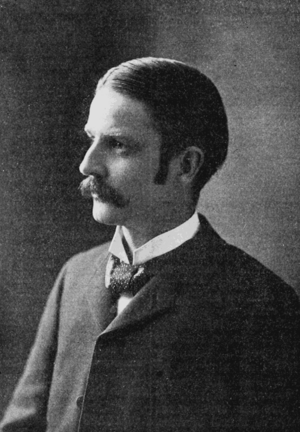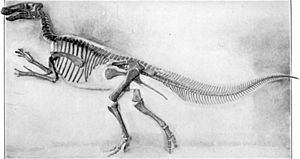Charles Emerson Beecher facts for kids
Quick facts for kids
Charles Emerson Beecher
|
|
|---|---|
 |
|
| Born | October 9, 1856 Dunkirk, New York, USA
|
| Died | February 14, 1904 (aged 47) |
| Nationality | American |
| Citizenship | American |
| Alma mater | University of Michigan Yale University |
| Known for | Invertebrate paleontology, Trilobite anatomy |
| Scientific career | |
| Fields | Paleontologist |
| Institutions | Yale Peabody Museum |
| Doctoral advisor | Othniel Charles Marsh |
| Influences | James Hall, Othniel Charles Marsh |
| Influenced | Charles Schuchert |
| Signature | |
Charles Emerson Beecher (born October 9, 1856 – died February 14, 1904) was an American scientist who studied fossils. He is best known for his amazing work on trilobites. These are ancient sea creatures that are now extinct. Beecher carefully dug up, prepared, and studied trilobite fossils. He focused on their underside, which helped scientists understand how they lived.
Beecher worked at the Yale Peabody Museum. He quickly moved up in his career there. Eventually, he became the head of the museum.
Contents
Early Life and Discoveries
Charles Emerson Beecher was born in Dunkirk, New York, on October 9, 1856. His parents were Moses and Emily Emerson Beecher. When he was young, his family moved to Warren, Pennsylvania. There, he went to private and high schools.
Charles loved nature and collecting things from a young age. He started collecting fossils from rocks near Warren. He found many fossils of ancient shrimp-like creatures called Phyllocarids. He also found freshwater mussels.
He gave a huge collection of these fossils to the New York State Museum in 1886 and 1887. This collection had about 20,000 specimens. Many of these were collected by Beecher himself when he was just a kid!
Beecher earned his first college degree (a Bachelor of Science) from the University of Michigan in 1878.
Becoming a Paleontologist
After college, Beecher worked for ten years with James Hall. Hall was a very important geologist in New York. Working with Hall taught Beecher a lot about studying fossils. He also became very good at preparing and photographing fossils. Hall often gave Beecher credit in his books for his help.
In 1888, Beecher moved to New Haven, Connecticut. He went there to work at the Yale Peabody Museum. He helped manage their growing collection of invertebrate fossils. Invertebrates are animals without backbones, like trilobites.
In 1891, Beecher earned his doctorate degree. He got it for his study of strange ancient sponges called Brachiospongidae.
Beecher's Trilobite Bed
Beecher was the first to carefully dig up a special layer of rock. This place is now named Beecher's Trilobite Bed after him. Fossils found here are incredibly well-preserved. Even the soft parts of the trilobites, which usually decay, turned into pyrite (fool's gold). This kind of fossil site is very rare and important. Scientists call it a Konservat-Lagerstätten.
Starting in 1893, Beecher published amazing papers about trilobites. He studied their structure, how they grew, and how they are classified. Thanks to his careful work, he figured out the structure of their antennae and legs. This was something no one had seen before!
Life at Yale and Later Career
Beecher's career at Yale grew quickly. In 1897, he became a Professor of Historical Geology. When Othniel Charles Marsh, the museum's curator, passed away in 1899, Beecher took his place. He became the Curator of Geological Collections at the Yale Peabody Museum. Later, his title changed to University Professor of Paleontology.
In June 1899, Beecher gave his own large fossil collection to the Peabody Museum. This collection had over 100,000 specimens. He had collected all of them himself over 20 years. It included many rare fossils and examples showing how ancient creatures developed. Everything was carefully labeled.
After becoming head of the museum, Beecher helped mount many fossils for display. One of the first was a nearly complete dinosaur skeleton. It was a hadrosaur (a duck-billed dinosaur) called Edmontosaurus. This was one of the first complete dinosaurs mounted in the United States. It was also one of the first to be shown with its spine flat, like a real animal, instead of standing upright with its tail dragging.
Sadly, Charles Emerson Beecher died suddenly on February 14, 1904, from heart disease. He left many studies unfinished. His friend and colleague, Charles Schuchert, took over his role at the museum.
Beecher's Impact on Science
Beecher's work greatly changed what we know about trilobites. His studies helped scientists compare trilobites to other ancient sea creatures. He also described how different types of trilobites developed.
While he is most famous for trilobites, Beecher also studied corals. He became a top expert on fossil crustaceans (like crabs and shrimp) and brachiopods (ancient shelled creatures). He also made important contributions to the study of evolution.
In 1901, Yale University reprinted some of Beecher's most important papers in a book called Studies in Evolution. This showed how important his work was. Beecher wrote over 100 scientific papers. In these papers, he described many new types of ancient animals.
Many leading science journals wrote about Beecher after he died. This shows how much he influenced the field of paleontology. Even almost 20 years after his death, his work on trilobites was still so important that a major study was dedicated to him.
Career Highlights
- Earned his B.S. degree from the University of Michigan in 1878.
- Worked as an assistant to James Hall at the New York State Museum from 1878 to 1888.
- Joined the Yale Peabody Museum as an assistant in 1888.
- Received his Ph.D. from Yale University in 1889.
- Became an instructor and then Assistant Professor of Paleontology at Yale's Sheffield Scientific School.
- Became Professor of Historical Geology at Yale in 1897.
- Became Curator of Geological Collections at the Yale Peabody Museum in 1899.
- Was a member of the National Academy of Sciences starting in 1899.
- Served as President of the Connecticut Academy of Arts and Sciences from 1900 to 1902.
- Became University Professor of Paleontology at Yale in 1902.


